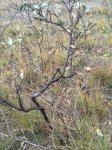Tycoss
Chumono
I found this elaeagnus commutata (wolf willow) growing out of an eroded slope. I really like the exposed roots, but I have two problems. Firstly, I have never collected this species. Always liked the foliage, flowers and twigging of the species.
 If anyone else has any experience with the species, I'd love to hear about it. Secondly, although I'm fascinated with the specimen, I have no idea how I'd style it after I dug it up. Any ideas?
If anyone else has any experience with the species, I'd love to hear about it. Secondly, although I'm fascinated with the specimen, I have no idea how I'd style it after I dug it up. Any ideas?

 If anyone else has any experience with the species, I'd love to hear about it. Secondly, although I'm fascinated with the specimen, I have no idea how I'd style it after I dug it up. Any ideas?
If anyone else has any experience with the species, I'd love to hear about it. Secondly, although I'm fascinated with the specimen, I have no idea how I'd style it after I dug it up. Any ideas?



